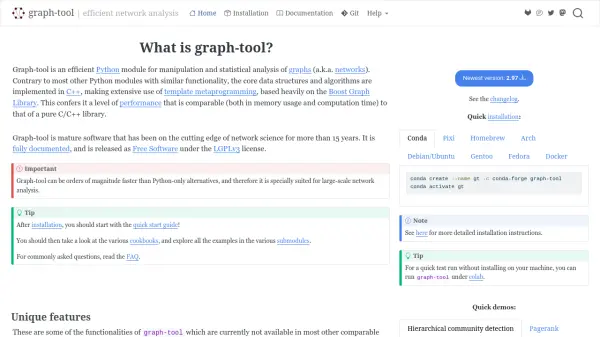What is graph-tool?
graph-tool is a state-of-the-art Python module designed for efficient manipulation and statistical analysis of graphs and network data. Unlike many other Python packages, it leverages C++ at its core, utilizing template metaprogramming and the Boost Graph Library to deliver unparalleled computational performance and memory efficiency. This makes it especially suitable for large-scale analyses that would challenge Python-only solutions.
The library provides a comprehensive suite of tools, including inferential community detection, uncertainty quantification, network reconstruction, and advanced network visualization. Its support for OpenMP parallelism enables the use of multi-core CPUs, and its integration with formats such as GraphML, GML, and dot files simplifies data import and export. With detailed documentation, frequent updates, and compatibility with the Netzschleuder network repository, graph-tool stands out as a mature solution for both researchers and industry professionals.
Features
- High Performance: Core algorithms implemented in C++ for increased speed and memory efficiency.
- Inferential Community Detection: Statistically principled community detection that avoids overfitting.
- Uncertainty Quantification: Provides methods for uncertainty analysis within network data.
- Parallel Processing: Leverages OpenMP for high scalability across CPUs.
- High-Quality Visualization: Static and interactive network visualization with matplotlib and animation support.
- Filtered and Masked Graphs: Efficient handling of filtered nodes and edges, accepted across all functions.
- Comprehensive File I/O: Supports GraphML, GML, dot files, pickling, and custom binary formats.
- Integration with Netzschleuder: Direct access and import of network data from the Netzschleuder repository.
- Extensible via C++: Advanced users can develop custom C++ extensions.
- Complete Documentation: Every function documented with examples and use cases.
Use Cases
- Performing large-scale social network analysis for academic research.
- Visualizing and interpreting complex biological or ecological networks.
- Detecting statistically significant communities in scientific network data.
- Quantifying uncertainty in dynamic economic or technological networks.
- Developing parallelized network analytics for proprietary business datasets.
- Importing and exporting advanced network formats for inter-software compatibility.
- Analyzing internet topology or infrastructure graphs.
- Customizing network algorithms with user-defined C++ extensions for enterprise needs.
FAQs
-
What programming languages does graph-tool support?
graph-tool is primarily a Python module, but its core algorithms are implemented in C++ for enhanced performance. -
Is graph-tool suitable for large networks?
Yes, graph-tool's efficient backend allows it to analyze networks of considerable size that would be prohibitively slow with pure Python alternatives. -
Does graph-tool provide comprehensive documentation?
Yes, the library offers detailed documentation for every function, including examples and tutorials. -
Can I visualize graphs interactively with graph-tool?
graph-tool supports both static and interactive network visualization capabilities, including animation and matplotlib integration.
Related Queries
Helpful for people in the following professions
graph-tool Uptime Monitor
Average Uptime
100%
Average Response Time
1012.3 ms
Featured Tools
Join Our Newsletter
Stay updated with the latest AI tools, news, and offers by subscribing to our weekly newsletter.





